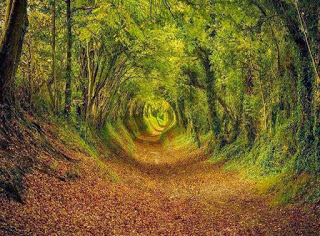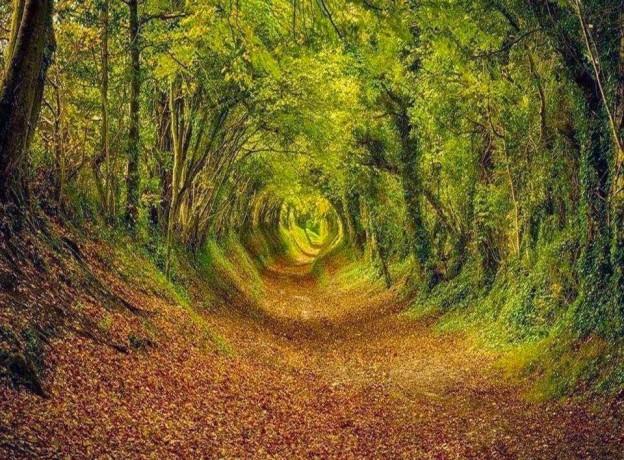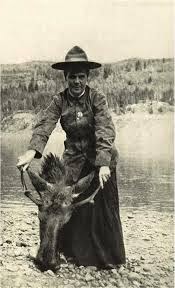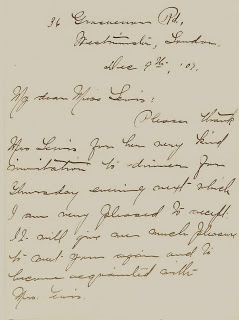
The Secret Places XXI & XXII
Continue reading



 The penultimate two chapters of The Secret Places (Elkin Mathews & Marrot London 1929) - a chronicle of the 'pilgrimages' of the author, Reginald Francis Foster (1896-1975), and his friend 'Longshanks' idly rambling in Sussex, Kent and Surrey. See our posting of the first chapters for more on Foster and this book, including a contemporary review in
The penultimate two chapters of The Secret Places (Elkin Mathews & Marrot London 1929) - a chronicle of the 'pilgrimages' of the author, Reginald Francis Foster (1896-1975), and his friend 'Longshanks' idly rambling in Sussex, Kent and Surrey. See our posting of the first chapters for more on Foster and this book, including a contemporary review in
The Tablet.

Two more chapters of The Secret Places (Elkin Mathews & Marrot London 1929) - a chronicle of the 'pilgrimages' of the author, Reginald Francis Foster (1896-1975), and his friend 'Longshanks' idly rambling in Sussex, Kent and Surrey. See our posting of the first chapters for more on Foster and this book, including a contemporary review in The Tablet.
Continue reading
Two more chapters of The Secret Places (Elkin Mathews & Marrot London 1929) - a chronicle of the 'pilgrimages' of the author, Reginald Francis Foster (1896-1975), and his friend 'Longshanks' idly rambling in Sussex, Kent and Surrey. See our posting of the first chapters for more on Foster and this book, including a contemporary review in The Tablet.
Continue reading
Two more chapters of The Secret Places (Elkin Mathews & Marrot London 1929) - a chronicle of the 'pilgrimages' of the author, Reginald Francis Foster (1896-1975), and his friend 'Longshanks' idly rambling in Sussex, Kent and Surrey. See our posting of the first chapters for more on Foster and this book, including a contemporary review in The Tablet.
Continue reading
Two more chapters of The Secret Places (Elkin Mathews & Marrot London 1929) - a chronicle of the 'pilgrimages' of the author, Reginald Francis Foster (1896-1975), and his friend 'Longshanks' idly rambling in Sussex, Kent and Surrey. See our posting of the first chapters for more on Foster and this book, including a contemporary review in The Tablet.
XI
THE FRIARY IN THE HILLS
It chanced that I had to go over into Surrey hm Sussex to pay a visit to the Franciscan Friary whence we had started on our wanderings. Leaving Longshanks, therefore, in an inn at Chidding in the fold country, whither we had gone in search of a man who claimed to be a direct descendant of Earl Godwin–though what he was doing here in the south I do not know–I went through the gap in the hills to Guildford and, being weary, took a ‘bus thence to Chilworth.
Because I was stupid with sleep I left that ‘bus at the wrong place, and, being unfamiliar with the country west of the Friary, I sought direction from a butcher and a queer man who carried a lighted lantern, though it was yet mid-afternoon. Thereafter I walked two miles, as I had been told, I came at last to a large crucifix by the roadside and entered the Friary grounds.
Continue reading

Two more chapters of The Secret Places (Elkin Mathews & Marrot London 1929) - a chronicle of the 'pilgrimages' of the author, Reginald Francis Foster (1896-1975), and his friend 'Longshanks' idly rambling in Sussex, Kent and Surrey. See our posting of the first chapters for more on Foster and this book, including a contemporary review in The Tablet.
IX
MY LADY OF THE MIST
To tell of the incidents of every day of our wanderings would be monotonous and wearisome, and so I make no effort to do so. Moreover, what is of interest, or gives happiness, to Longshanks and myself is not necessarily entertaining to anyone else. And because we had no aim but aimlessness–which is good for men sometimes–we wandered from county to county as the spirit moved us, having no regard for even a daily itinerary or for a settled account when our adventures should be written down.
It was at Small Dole–which is in Sussex–that we discussed, the relative merits of hot and cold shoeing with the big blacksmith, and when we had worked him to a passion of rage at our obstinacy, so that he stuck out his big fan of a beard at us and cursed us with a strange oath, we were minded to continue our journey to the Downs. It was not long after dawn, and October rime still lay where the sun had not yet thawed it.
Continue reading

Two more chapters of The Secret Places (Elkin Mathews & Marrot London 1929) - a chronicle of the 'pilgrimages' of the author, Reginald Francis Foster (1896-1975), and his friend 'Longshanks' in Sussex, Kent and Surrey. See our posting of the first chapters for more on Foster and this book, including a contemporary review in The Tablet.
THE WOOD OF MYSTERY
Leatherhead used to be famous for its "nappy" ale, as King Henry the Eighth's laureate knew, for he wrote a song about the mistress of the Running Horse Inn and praised the brew, as a man should. And the Mole, which chatters its way half round the town, was famous for its trout. Alas! in these days the ale there is no better than it should be, and of trout there are none–at least Longshanks and I were not served with any.
But Leatherhead has its distinction even now, and you shall mark it whether you proceed thither by train, by car, or on foot. For at Leatherhead the rather threadbare rusticity of the country south of London ends, and when you have climbed the steep hill beyond the bridge on the Guildford road you are in a new land. In the little rectangle of which one side is the main road between Leatherhead and Dorking, and the opposite side an imaginary line running through Little Bookham and Effingham and ending roughly five miles due ; west of Dorking, you may get lost an hundred times.
I scruple to say how this may be done, for when a horde of people get lost together there is no mystery nor any fear; only paper bags and bottles left on the eternal hills and in the secret places of the woodland. And so I shall be vague.
Continue reading

Two more chapters of The Secret Places (Elkin Mathews & Marrot London 1929) - a chronicle of the 'pilgrimages' of the author, Reginald Francis Foster (1896-1975), and his friend 'Longshanks' in Sussex, Kent and Surrey. See our posting of the first chapters for more on Foster and this book.
Continue reading

Mina Hubbard (1870 – 1956) is not a name that means much in the UK, although this intrepid explorer of Labrador ( the first woman to do so) retired to Britain and ended up in suburban Coulsdon, of all places, where she died rather tragically at the age of 86.
Born in Bewdley, Ontario, in 1870, to a Canadian father and an English mother, there was little in her early years that would suggest that worldwide fame as an explorer would attend her by the time she was 35. After leaving school she spent two years teaching, then trained as a nurse. It was while nursing that she met the journalist Leonidas Hubbard, then ill with typhus (or typhoid). The couple married in 1901 and within 2 years he had embarked on an unsuccessful expedition to map northern Labrador that ultimately cost him his life. Such a tragedy would have destroyed some women, but Mina was made of sterner stuff. When Dillon Wallace, a survivor of the expedition, published his account Mina suspected that he had been responsible for her husband’s death through starvation and vowed to revenge herself on him by embarking on her own expedition to achieve what he and her husband had failed to do. Recruiting three guides, two of them Cree Indians, she left for Labrador on June 27th 1905 and by 29th August had completed a trek of 576 miles, beating Wallace, who had embarked on the same day, by seven weeks. Not only did she bring home an accurate map of northern Labrador, but she also made an important photographic record of the native Labradorians she had met.
 On her return home Hubbard became an overnight celebrity. Before long she had been sponsored by the Royal Geographical Society to undertake a lecture tour in England. It was while on that tour that she wrote this letter to a Miss Lewis (possibly an admirer) gratefully accepting an invitation to dinner. She also met her second husband, the MP Harold Ellis. In 1908 appeared A Woman’s Way through Unknown Labrador , which became a best-seller. Today this account of her expedition, and in particular the photographs she took of the native tribes, is generally recognised as one of the most valuable anthropological records of the period. More recently, however, it has sparked controversy. In particular, feminist commentators have interpreted the text as a seminal document in women’s studies. Hubbard’s projected persona in the book is seen as that of a woman performing a male role as a conqueror of a hostile environment.
On her return home Hubbard became an overnight celebrity. Before long she had been sponsored by the Royal Geographical Society to undertake a lecture tour in England. It was while on that tour that she wrote this letter to a Miss Lewis (possibly an admirer) gratefully accepting an invitation to dinner. She also met her second husband, the MP Harold Ellis. In 1908 appeared A Woman’s Way through Unknown Labrador , which became a best-seller. Today this account of her expedition, and in particular the photographs she took of the native tribes, is generally recognised as one of the most valuable anthropological records of the period. More recently, however, it has sparked controversy. In particular, feminist commentators have interpreted the text as a seminal document in women’s studies. Hubbard’s projected persona in the book is seen as that of a woman performing a male role as a conqueror of a hostile environment.
The Ellises produced three children, but the couple parted in the twenties and Mina returned to Canada in 1936. After this she seems to have led a rather conventional life, latterly in poverty. In 1956, while staying with a friend in Coulsdon, near Croydon, she left the house to ‘ explore’ and on her way to the nearby Coulsdon South station she wandered aimlessly over the tracks, was hit by a speeding train and killed instantly. She was 86. What the grizzly bears and below zero temperatures of Labrador had failed to do, a British Railways commuter train had completed. [RMH]

Two more chapters of The Secret Places (Elkin Mathews & Marrot London 1929) - a chronicle of the 'pilgrimages' of the author, Reginald Francis Foster (1896-1975), and his friend 'Longshanks' in Sussex, Kent and Surrey. See our posting of the first chapters for more on Foster and this book..
Continue reading
 |
| Ashdown Forest* |
These are the first two chapter of The Secret Places (Elkin Mathews & Marrot London 1929) - a chronicle of the 'pilgrimages' of the author, Reginald Francis Foster (1896-1975), and his friend 'Longshanks' in Sussex, Kent and Surrey. One of those magical walking/ rambling books that appeared in the 1920s and 1930s while, to quote Waugh, 'the going was good' despite ribbon development and the ubiquitous motor car. It was probably aimed at urban and suburban dwellers who got away to the country at weekends or when they could. Foster was a jobbing journalist who also wrote books on the countryside and how-to-write books. Most of this book had appeared in the Evening News in the late 1920s. He also wrote detective fiction. Between 1924 and 1936, according to Hubin, he produced 11 mysteries, some featuring a detective called Anthony Ravenhill (The Dark Night, The Missing Gates, The Moat House Murder etc.,) This contemporary review of The Secret Places in The Tablet gives a flavour of the work. There follows the first two chapters…(more to come)
We like The Secret Places. Mr. R. Francis Foster knows where treasure lies hid, and would gladly share his secret with those worthy of the trust. But he fears the barbarian motorist, "with soul so dead" that he is to be stirred only by speed records until the love of country cannot touch him. Therefore he compromises by describing byways where the demon speed cannot go : quiet, ancient ways to be trodden only by the feet of the humble pilgrim in quest of peace and beauty. The author himself trod these paths with a fitting companion, setting out in the autumn along the Pilgrims' Way and wandering through the counties of Surrey, Sussex and Kent until Spring, bringing alas, a plague of cars in her train, drove the travellers from the roads ! Then they ended their journey at Chilworth Friary, where it had begun, convinced that cars are a curse of the devil, and that "the limit in permissible inventions should be the bicycle, foot propelled." This little volume, although perhaps rather self-conscious in the writing, will please lovers of the English countryside and leave them with many delightful things 'pleasant to think on.' We should like to know more of Zebedee, the Zebra, a strange gift-horse to the pilgrims whose fate, after his total disappearance by night, they never seem to have found out.
Continue reading